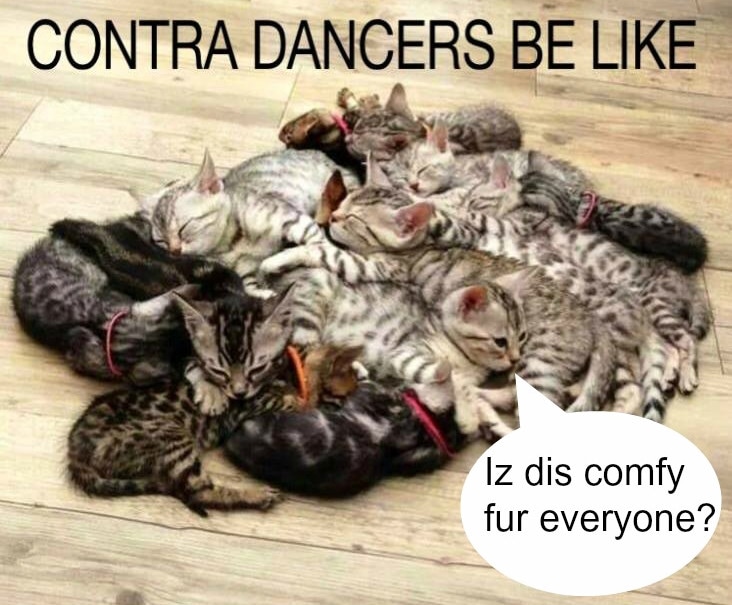Ask, "Would you like to dance?" and move on gracefully if the answer is, "No, thanks!"
Many of us grew up socialized to put others' feelings before our own needs and wants; deep down, we might might be afraid of how someone will react if we say "No." Remember: It's ok to say "No" to anyone, for any reason, at any time.
Hearing "No" to a request can be challenging, especially if you come from a dance culture where turning down a dance wasn't always common practice. There are lots of reasons someone might not want to dance: tiredness, injury, thirst, sensitivity to fragrances, type of dance, and the tempo of the music are just a few. When someone turns you down, chances are, it has nothing to do with you. When you accept a "No" with good grace, you help establish a culture that values the comfort of other dancers.
I encourage dancers to say "No, thanks" when they don't want to dance for whatever reason, and leave it at that. It takes less time than an excuse, allowing the asker more time to find a partner, and helps establish a simple "No" for any reason as the social norm.
If you receive a "No, thanks!" many dancers prefer that you don't ask them to dance again that evening, unless they've said something like, "No, thanks! How about later?" You can also respond to "No, thanks!" with, "Cool. Find me later if you'd like to dance!" Remember: If someone says they'd like to find you later and doesn't, guilt tripping is generally not welcome.
Hearing "No" to a request can be challenging, especially if you come from a dance culture where turning down a dance wasn't always common practice. There are lots of reasons someone might not want to dance: tiredness, injury, thirst, sensitivity to fragrances, type of dance, and the tempo of the music are just a few. When someone turns you down, chances are, it has nothing to do with you. When you accept a "No" with good grace, you help establish a culture that values the comfort of other dancers.
I encourage dancers to say "No, thanks" when they don't want to dance for whatever reason, and leave it at that. It takes less time than an excuse, allowing the asker more time to find a partner, and helps establish a simple "No" for any reason as the social norm.
If you receive a "No, thanks!" many dancers prefer that you don't ask them to dance again that evening, unless they've said something like, "No, thanks! How about later?" You can also respond to "No, thanks!" with, "Cool. Find me later if you'd like to dance!" Remember: If someone says they'd like to find you later and doesn't, guilt tripping is generally not welcome.
Ask role preferences: "Would you like to lead, follow, or switch?"
You can use whatever terminology for roles you think is most appropriate. Many folks prefer a certain role due to physical limitations; others enjoy exceeding the expectations of the other dancers on the floor by dancing a particular role.
"Switching, swapping, or liquid leading" refer to when the roles shift throughout the course of the dance. "Stealing" is when the dancer in the follow position temporarily takes control over the dance - like backleading, but with playful intent.
"Switching, swapping, or liquid leading" refer to when the roles shift throughout the course of the dance. "Stealing" is when the dancer in the follow position temporarily takes control over the dance - like backleading, but with playful intent.
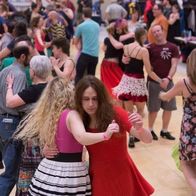 Lucy Schultz Photography
Lucy Schultz Photography
"One of the things I've worked on in dance spaces is asking people whether they would like to lead or follow. It always makes me feel warm and fuzzy when people don't assume my dance role based on my appearance, and I try my best to extend the same courtesy to others."
Check in about injuries or physical limitations, especially those that might not be visible.
Your partner might have a visible cue, such as an arm brace or a sign, that they have a physical limitation they need to be careful of, but many injuries or disabilities are invisible. Either way, all bodies are different: when possible, don't make assumptions - ask what you can do to make your dance smooth, safe, and pain-free.
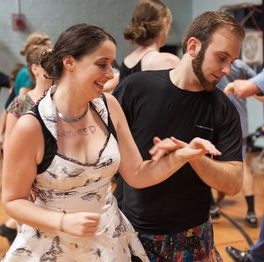 Image by Ryan Carollo.
Image by Ryan Carollo.
"I've had a chronic (and invisible) injury for years that absolutely can't be aggravated without severely affecting the rest of my life, but I still dance occasionally because it's a huge part of my life. For a long time, I was getting constantly torqued on and set back by folk assuming that I could dance the same way every time. Now, people in communities I frequent have taken to asking every time they see me, for every dance, where my body is at and what I currently need to accommodate my injury. I'm now able to dance an entire night and stay functional because my community decided the effort of communicating was worth it to keep me safe.
Check that lifts, dips, and flourishes are safe, and wanted.

Sometimes the dance floor is too crowded for comfort, or maybe your partner is hurting from a previous dance... There are lots of reasons why checking in before lifts, dips and flourishes is a good idea, even if you've partnered before. If you're trying out a new move, getting consent first is especially important. No one ever intends to cause harm to their partner, but accidental injuries can mean months of pain, not to mention time away from dancing.
"There's a man I danced with a few times while I was traveling, who was awesome at lifts! I really appreciated that not only did he ask at the beginning of the dance if I liked lifts and dips, but he made eye contact and I gave him a little nod before every lift. It made for a super fun and really connected dance!"
"There's a man I danced with a few times while I was traveling, who was awesome at lifts! I really appreciated that not only did he ask at the beginning of the dance if I liked lifts and dips, but he made eye contact and I gave him a little nod before every lift. It made for a super fun and really connected dance!"
If your dance style involves the possibility for additional closeness, check in before initiating.
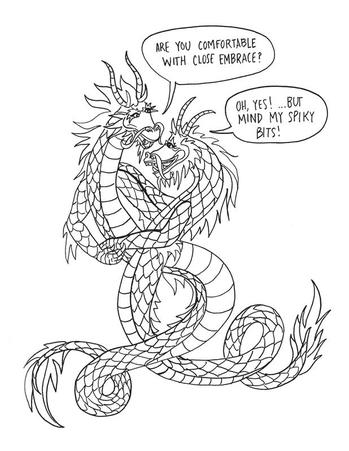
Close embrace in blues dancing, or blues swings in contra can bring a beautiful intimacy and connectedness to a dance. Remember that everyone has different boundaries and comfort levels, and verbally checking in first makes that level of connection much more easily attainable.
If your partner brings up something that would make them more comfortable during your dance, enthusiastically accommodate them to the best of your ability.
No one wants to be in pain, or to cause pain on the dance floor. If your partner does communicate that they'd like to change something, saying "Thanks for letting me know!" when making the adjustment is a great way to show that you value their safety and comfort.
"I was dancing with a partner who was inadvertently hurting me, several times consecutively in the same way. Finally I said, "That hurts, can you please shift your arm?" Her response was "thank you!"and she adjusted immediately. It's the simplest, nicest way I've had that kind of exchange -- rather than being embarrassed or defensive at my feedback, a simple thanks for sharing. The rest of our dance was great."
Ask for feedback on your dancing, and be open to making changes.
Hopefully your partner feels safe telling you when something would make them more comfortable while dancing with you, but there are many reasons why they might hesitate to start the conversation. Inviting feedback and checking in are great ways to show that you care, and can take a little constructive criticism.
Ask before touching someone else's body in ways that aren't part of the dance.
Asking before touching is especially appreciated when it comes to tattoos, hair, and other body adornments. It's ok to be curious about and admire other people's choices, but remember that everyone has different boundaries that deserve to be respected.
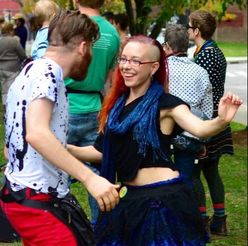 Image by Nick Alunni
Image by Nick Alunni
"I'm a small woman, and throughout my life strangers have occasionally behaved as if they're entitled to touch my body. Women often like to touch my long hair, which I'm sure they mean as a compliment or a motherly gesture... and everyone wants to rub the shaved side of my head. But having someone touch your head is pretty intimate, and pretty uncomfortable when that person is a complete stranger, or even a friend to be honest. To me, those small actions feel like a reinforcement of the idea that because I'm small, I'm powerless. When people ask if they can rub my head before they reach out and touch me, or compliment me with their words rather than their hands, it shows me that they care about me and how I feel."
If you like to hug your partner at the end of your dance, ask verbally first.
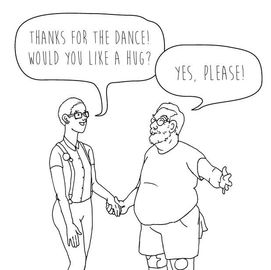
Hugs are lovely ways to conclude a dance, but they're not for everyone. Remember, consent for touch in the context of the dance is not consent for touch outside of the dance. Asking verbally for hugs is a great way to show your partner that you value their comfort.
Consider asking before photographing.

While photography and video are part of our culture, keep in mind that it may make some dancers uncomfortable. Some prefer to have separation between their personal and professional lives, and to that end prefer not to be tagged in photos and video on social media. If your dance has a "photo-free" line or section, please respect it.
"When folks do [ask before taking my picture], I feel pretty pleased, respected, and safe.""I feel pretty pleased, respected and safe" bit?
"When folks do [ask before taking my picture], I feel pretty pleased, respected, and safe.""I feel pretty pleased, respected and safe" bit?
If your dance community does cuddle puddles, remember to check your cuddle splash zone before diving in, and to make sure to check in with your cuddle buddies to ensure that no one is suffering in silence.
Remember that dancing doesn't imply consent for more.
Remember that dancing can be an intimate experience, but even "sexy dancing" doesn't imply consent consent for sexual contact on or off the dance floor. If you're wondering if a dance might lead to something more, check in verbally and clearly with your partner before proceeding.
What if I mess up?!
Take a deep breath! Everyone makes mistakes sometimes, and everyone has room to grow. Most of us did not grow up in a culture that prioritized consent, and learning takes time and effort.
There's still time to show your partner that you care, which can be as simple as, "Oops! I'm sorry, I should have asked first." If the situation calls for it, consider making a genuine apology, which recognizes what went wrong, and makes a commitment to do something specific differently in the future. For example: "I'm so sorry I bumped you! I'll remember not to try that move in such a crowded space next time! Are you ok?"
There's still time to show your partner that you care, which can be as simple as, "Oops! I'm sorry, I should have asked first." If the situation calls for it, consider making a genuine apology, which recognizes what went wrong, and makes a commitment to do something specific differently in the future. For example: "I'm so sorry I bumped you! I'll remember not to try that move in such a crowded space next time! Are you ok?"
"Once upon a time, a close friend of mine playfully bit my neck while we were dancing. Some minutes later, after we'd finished dancing and were just chatting, she looked at me in startled horror and said, "Oh my gosh, I didn't ask before biting you, I'm so so so sorry!" Even though I hadn't minded in the moment, it probably also would've occurred to me sometime later that being bitten without being asked first wasn't good consent practice. Because of the way she handled it, I felt comfortable and respected and told her truthfully that I didn't mind at all. This is a moment that stands out to me as a strongly positive example where the person's attitude and consideration for my feelings AFTER the potential boundary violation were able to quickly and effectively heal any damage that had been done with the thoughtlessness of their initial behavior."
